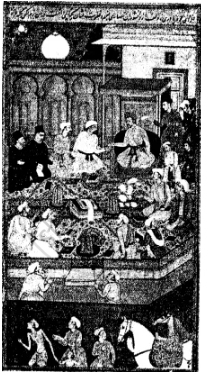Advertisements
Advertisements
प्रश्न
What was the extent of Akbar’s kingdom? How was administration carried out during Akbar’s time? Explain with reference to the Central and Provincial administration.
उत्तर
Akbar’s empire extended from Bengal in the east to Afganistan in the west and from the Himalayas in the north to the Godavari river in the south. His vast empire was divided into fifteen provinces. They were Kabul, Lahore, Multan, Delhi, Agra, Allahabad, Oudh, Gujarat, Ajmer, Malwa, Bihar, Bengal, Khandesh, Berar, Ahmednagar. The Akbar administration was divided into Central and Provincial administration.
Central Administration
The emperor was assisted by a team of ministers and officials for the proper administration of the empire. Their names and functions are as follows:
- Wazir Dewan: He was the head of the revenue department.
- Mir Bakshi: He was the head of the military department and the paymaster of all mansabdars.
- The Qazi: He was the chief judge.
- Chief Sadr: He was the supervisor of the royal household.
- Vakil: He was the head of the advisory board.
Provinical Administration
Akbar’s empire was divided into fifteen provinces or Subas, which-were further subdivided into Sarkars, and these in turn into Parganas. Each Pargana comprised a number of villages. Each province was under the charge of a subedar, who had full civil and military powers. The Subehdar was assisted by a number of officials like provincial Diwan, Bakshi, Qazi, kotwal and a number of other officials
APPEARS IN
संबंधित प्रश्न
Important Words:
chief sadr
State whether the following statement is True or False:
Akbar reimposed Jazia on the non-Muslim subjects.
Choose the correct answer:
The court language used in Akbar’s court was __________.
Answer the following question in one or two words/ sentences:
What do you understand by the term ‘mansab’?
Answer the following question briefly:
Why was Akbar’s position unstable and insecure when he ascended the throne of Delhi?
Answer the following question briefly:
Who assisted the emperor in the administration of the empire? What were their responsibilities and functions?
Explain the important features of the land revenue system introduced by Todar Mal.
Answer the following question briefly:
Mention the important features of Akbar’s Rajput policy. Why did he adopt this policy and what were its results?
The picture depicts a Mughal emperor holding discussions on religious matters in the Ibadat Khana.

Identify the emperor.
Discuss Akbar’s revenue system with reference to Survey and assessment of land
